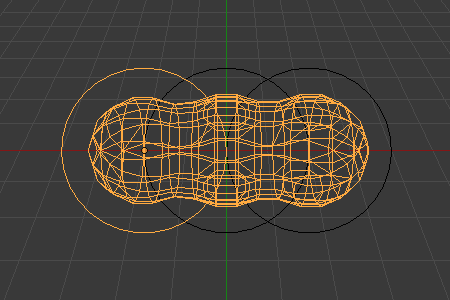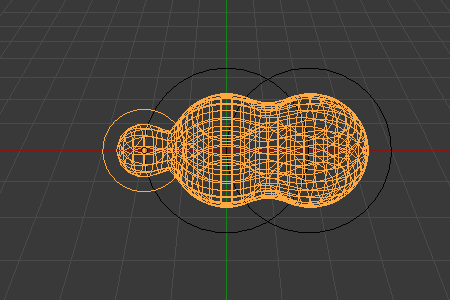Edición
Además de tener varios meta objetos en una misma familia, también puede tener varios meta primitivos en un solo objeto (simplemente agregue algunos más en el Modo Edición). Cada uno será un elemento, con su propia forma, anillos de edición (en la vista) y configuraciones.
Eliminando Elementos
Referencia
- Atajo
X, Suprimir
You can only delete the active element, no fancy options here.
Conversión
To convert the meta to a real mesh, use Convertir in Object Mode.
Familias de Objeto
A «family» is a way to regroup several meta objects, producing something very similar to having several metas inside the same object.
It is defined by the left part of an object’s name (the one before the first dot).
Remember, an object’s name is the one in the Object Name field, in most panels,
not the Metaball Name field, which is the meta data-block’s name…
For example, the family part of «MetaPlane.001» is MetaPlane.
Each meta object in the same «family» is associated with one another as discussed below.

Familia de Metabola.
Families of metas are controlled by a base meta object which is identified by
an object name without a dot in it. For example,
if we have three metas called MetaThing, MetaThing.001,
MetaThing.round, the base meta object would be MetaThing.
The base meta object determines the basis, the resolution, the threshold, and the transformations. It also has the material and texture area. In a way, the base meta is the «owner» of the other metas in the family (i.e. it is as if the other metas were «included» or joined into the base one).
Consejo
When working with multiple scenes, take care naming your meta objects so the base is always in the same scene as other metas.
Failing to do so will give confusing behaviors (like invisible meta objects).
Ejemplos
Fig. Meta ball base. shows the base meta labeled «B». The other two Meta objects are children. Children’s selection rings are always black, while the group’s mesh is orange. Because the metas are grouped, they form a unified mesh which can always be selected by selecting the mesh of any meta in the group.

Meta ball base.
For example, in Fig. Meta ball base., only the lower sphere (the parent) has been selected, and you see that both the parent’s mesh and all of the children’s meshes are now highlighted.

Scaling the «base».
The base meta object controls the polygonalization (mesh structure) for the group, and as such, also controls the polygonalization for the children (non-base) metas. If we transform the base meta, the children’s polygonalization changes. However, if we transform the children, the polygonalization remains unchanged.
Consejo
This discussion of «polygonalization» does not mean that the various meshes do not deform towards or away from each other (meta objects always influence one another in the usual way, within a same family).
Rather, it means that the underlying mesh structure changes only when the base object transforms. For example, if you scale the base, the children’s mesh structure changes.
In Fig. Scaling the «base»., the base has been scaled down, which has the effect of scaling the mesh structure of each of the children. As you can see, the children’s mesh resolution has increased, while the base decreased. The children did not change size!